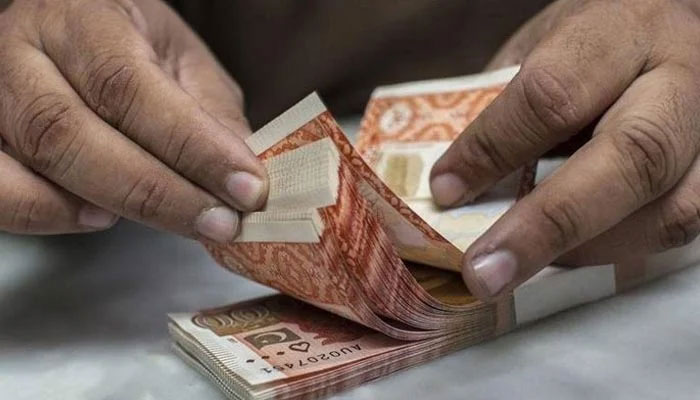Rupee seen steady as foreign reserves hold up, IMF hopes rise
KARACHI: The rupee is expected to trade in a narrow range over the coming week, buoyed by stable foreign exchange reserves and optimism over a new International Monetary Fund loan program.
“After losing some ground in the previous sessions, I expect that the rupee will show a steady trend in the next week,” a forex trader said.
“The main justification for this prediction is that the central bank's foreign exchange reserves remained above $8 billion even after the $1 billion Eurobond repayment last week. Other contributing factors include the weak dollar demand from importers.”
“Thanks to the encouraging reports from Pakistan's Finance Minister's visit to the US, investor confidence in the country’s currency and economy is growing.”
Pakistan has made a formal request to the IMF for obtaining a fresh bailout in the range of $6 to $8 billion under the Extended Fund Facility to fix its economy.
According to Finance Minister Muhammad Aurangzeb, Pakistan aims to finalise the details of a new IMF programme by May.
The country's current $3 billion agreement with the international lender expires in late April, and the minister stated that to help ensure macroeconomic stability and provide a framework for implementing urgently needed structural reforms, the government is looking for a longer and larger bailout from the IMF.
The rupee ended Monday's interbank market trading at 278.12 against the US dollar. On Friday, it closed at 278.30.
The rupee saw a minor hiccup last week, shedding roughly 40 paisas against the US dollar, according to a client note from Tresmark.
“While the change was small, it was the trend reversal which surprised the market, even though news flow was mostly positive for Pakistan,” it said.
“Traders blamed the Rupee weakness on broad dollar strength, which has gained against most major currencies and even regional currencies including the Indian Rupee, Lira, and Ringgit. The Rupee also lost some value due to a large oil payment,” it added.
But considering the successful large repayment of $1bn bonds, such a small movement is relatively ignorable, it noted.
“Going forward, we continue to see Rupee stability, but post June crossing, we may see a gradual depreciation of the currency.” Tresmark said.
“This view also coincides with the finance minister’s view, who said he doesn’t expect any substantial deterioration over next year other than the historic average of 6-8 percent.”According to it, swaps premiums have recovered but large-ticket forward sales are missing. Smaller amounts and some exporters selling their proceeds to lock in profit margins are still being conducted. Forward selling should pick up if news of Saudi inflows or the Crown Prince Mohammed bin Salman's visit to Pakistan gets confirmed.
The confrontation between Iran and Israel and the Fed’s turn has been two unsettling developments in the last couple of weeks. The first's effects, such as the price of gold and oil, supply-side shocks, and business disruptions, are quite obvious. The Fed's pivot, on the other hand, has more concerning effects, such as safe haven flows, dollar strength, and an abrupt shortage of liquidity. Although these threats affect the entire world, emerging markets are more severely affected.
-
 Kanye West Eyes Performing First-ever Concert In India
Kanye West Eyes Performing First-ever Concert In India -
 Brooklyn Beckham's Claim About Nicola's Wedding Ordeal Gets Challenged
Brooklyn Beckham's Claim About Nicola's Wedding Ordeal Gets Challenged -
 AI Horror: 4 In 5 Young Workers Fear 'AI Could Replace Their Jobs', Says Report
AI Horror: 4 In 5 Young Workers Fear 'AI Could Replace Their Jobs', Says Report -
 Missouri Couple ‘locked Sons In Chicken Pen, Shot Them’ In Shocking Abuse Case
Missouri Couple ‘locked Sons In Chicken Pen, Shot Them’ In Shocking Abuse Case -
 King Charles Receives 'delightful' Royal Baby News
King Charles Receives 'delightful' Royal Baby News -
 Chinese ‘mega Embassy’ Wins UK Approval In London Ahead Of Starmer’s China Visit
Chinese ‘mega Embassy’ Wins UK Approval In London Ahead Of Starmer’s China Visit -
 David Beckham Gives Telling Reaction To Brooklyn’s Public Complaints
David Beckham Gives Telling Reaction To Brooklyn’s Public Complaints -
 Can Ibuprofen Cut Cancer Risks? Study Finds Promising Breakthrough
Can Ibuprofen Cut Cancer Risks? Study Finds Promising Breakthrough -
 Piers Morgan Finally Reacts To Brooklyn Beckham's Statement About David And Victoria Beckham
Piers Morgan Finally Reacts To Brooklyn Beckham's Statement About David And Victoria Beckham -
 Tom Hiddleston Reveals Unlikely DC Character That Inspired Loki
Tom Hiddleston Reveals Unlikely DC Character That Inspired Loki -
 Prince Harry, Meghan Markle Warned 2026 Will Be 'a Big Test' For Them
Prince Harry, Meghan Markle Warned 2026 Will Be 'a Big Test' For Them -
 OpenAI Plans First ChatGPT Device For 2026
OpenAI Plans First ChatGPT Device For 2026 -
 Matt Damon Gets Slammed Over 'out Of Touch' Comparison
Matt Damon Gets Slammed Over 'out Of Touch' Comparison -
 From Chagos Islands To Greenland Trump Flags National Security Risks: Here’s Why
From Chagos Islands To Greenland Trump Flags National Security Risks: Here’s Why -
 Meghan’s UK Return As ‘successful Businesswoman’ Will Put Pressure On Kate Middleton
Meghan’s UK Return As ‘successful Businesswoman’ Will Put Pressure On Kate Middleton -
 Spotify Tests Page Match To Sync Books With Audiobooks
Spotify Tests Page Match To Sync Books With Audiobooks




